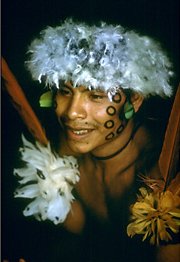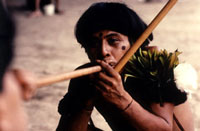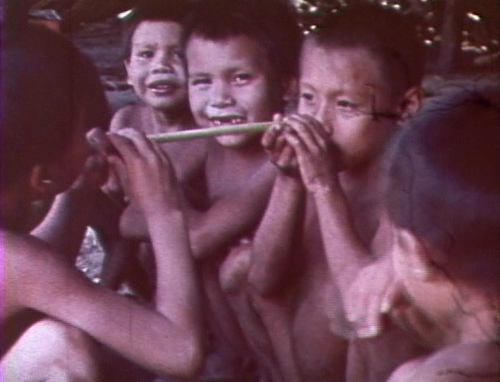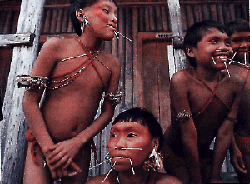- hukura = spirits
-
-
-
-
(Bryant, DeWalt, Courtney and Schwartz 2003)
-
-
-
- including ambivalent
- a person can simultaneously have positive and negative views or feelings
- or no particular views or feelings
-
- (H. Barnett, et al)
-
- alcohol / drugs
- trance
- shamanistic ecstasy
- sorcery
- dance trance
- prayer ecstasy
- yoga / meditation
- dream states
- "highway hypnosis"
- . . .
-
- shaman
- Yanomamó Kin Terms = Iroquois Terminology
Notes
-
For a look at how the Yanomamö changed in the next few years after this film was made see Ocamo is My Town (VC 1339), a film / video first released by Pennsylvania State University in 1975. For a more recent portrait see Warriors of the Amazon (VC 2667), by WGBH Educational Foundation, ca. 1996.
Cultures
Sites
Individuals
Other Videos
References
- Darkness in El Dorado Controversy --Texas A & M
- Yanomamö -- Anthro.Net
- The Yanomamö -- Brian Schwimmer
- Yanomamö Interactive Video -- John Kantner, UC Santa Barbara
- The Anthropology Resource Center. 1981. The Yanomami Indian Park: A Call for Action. Boston: MA.
- Baker, Paul. 1972. Review of 16 mm film, Yanomamö: A Multidisciplinary Study. American Anthropologist, 74:195-196.
- Chagnon, Napoleon A. 1967. "Yanomamö -- The Fierce People." Natural History Magazine 76:1:22-31.
- Chagnon, Napoleon A. 1968. "The Culture Ecology of shifting (Pioneering) Cultivation among the Yanomamo Indians," Proceedings of the VIII International Congress of Anthropological land Ethnological Sciences, 3:249-255. (Reprinted in D. Gross, ed., Peoples and Cultures of Native South America. Garden City, N.Y.: Doubleday.
- Chagnon, Napoleon A. 1968. Yanomamö The Fierce People. NY: Bolt, Rinehart, and Winston.
- Chagnon, Napoleon A. 1968. "Yanomamö Social Organization and Warfare in War: The Anthropology of Armed Conflict and Aggression by Morton Fried, Marvin Harris, and Robert Murphy (eds.). NY: Natural History Press.
- Chagnon, Napoleon A. 1972. "Tribal Social Organization and Genetic Micro- differentiation," in The Structure of Human Populations, G. A. Harrison and A. J. Boyce, eds., Oxford: Clarendon Press, pp. 252-282.
- Chagnon, Napoleon A. 1967. Studying the Yanomamö. NY: Bolt, Rinehart and Winston.
- Chagnon, Napoleon A. "The Ecology of Swidden Cultivation in the Upper Orinoco Rain Forest, Venezuela." The Geographical Review 64:4:475-495.
- Chagnon, Napoleon A. 1972. "Tribal Social Organization and Genetic Micro- differentiation," in The Structure of Human Populations, G. A. Harrison and A. J. Boyce, eds., Oxford: Clarendon Press, pp. 252-282.
- Chagnon, Napoleon A. 1973. "Yanomamo," in Primitive Worlds, Washington, D.C.: National Geographic Society, Special Publications series, pp. 141-183.
- Davis, Sheton H. 1976. Victims of the Miracle: Development and the Indians of Brazil. Cambridge Univ. Press.
- Davis, Sheton H. 1984. "Highways and the Future of the Yanomamo." In Conformity and Conflict, Ed. by James P. Spradley and David W. McCurdy, pp. 374-383. Boston: Little, Brown.
- Hannah, Joel M. 1972. Review of Yanomamö: A Multidisciplinary Study, American Journal of Physical Anthropology. 36: 453-454.
- Harris, David R. 1971. "The Ecology of Swidden Cultivation in the Upper Orinco Rain Forest, Venezuela." The Geographical Review, 61 (4) 475-495.
- Kensinger, Kenneth M. 1971. Review of The Feast, American Anthropologist, 73: 500-502.
- Lizot, Jacques. 1985. Tales of the Yanomami. Cambridge Univ. Press.
- MacCluer, J., J. Neel, and N. Chagnon. 1971. "Demographic Structure of a Primitive Population: A Simulation," American Journal of Physical Anthropology, 35:193-207.
- Neel, James V. 1970. "Lessons from a 'Primitive' People." Science, 170: 815-822.
- Neel, J. V., W. R. Centerwall, N. A. Chagnon, and H. L. Casey. 1970. "In a Virgin-Soil Population of South American Indians," American Journal of Epidemiology, 91:418-429.
- Neel, J., et al. 1971. "Studies on the Yanomama Indians," Proceedings of the Fourth International Congress of Human Genetics. Human Genetics, September 1971, pp. 96-111.
- Neel, James V. and Richard H. Ward. 1970. "Village and Tribal Genetic Distances among American Indians, and the Possible Implications for Human Evolution," Proceedings of the National Academy of Sciences, 65 (2):323-330.
- Salamone, Frank A. 1997. The Yanomami and their interpreters : fierce people or fierce interpreters? Lanham, Md. : University Press of America.
- Ward, Richard H. 1971. "The Genetic Structure of a Tribal Population: The Yanomama Indians. V. Comparison of a Series of Networks," Annals of Human Genetics.
- Yanomamö women -- MedLibrary.org
|






